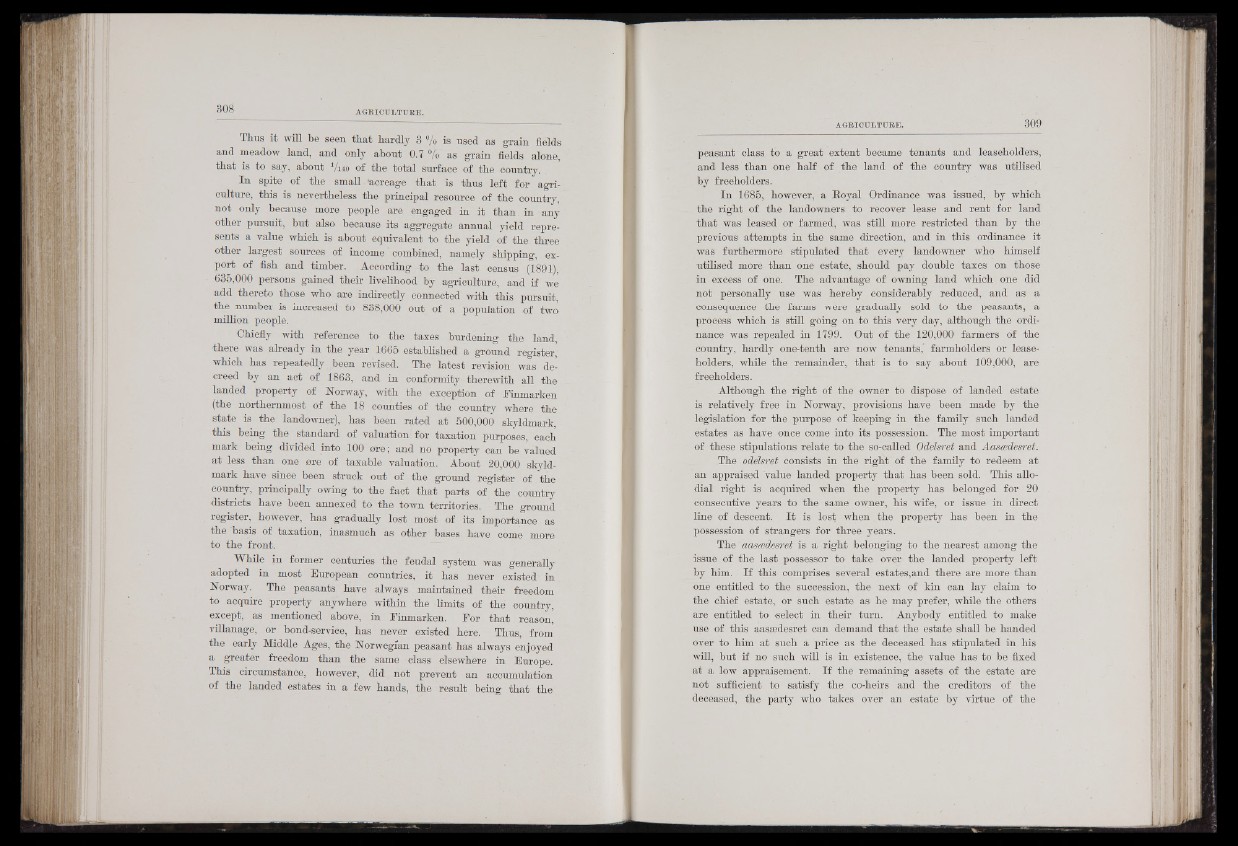
Thus it will be seen that hardly 3 % is used as grain fields
and meadow land, and only about 0.7 °/<T as grain fields alone,
that is to say, about Yi«> of the total surface of the country.
In spite of the small «acreage that is thus left for agriculture,
this is nevertheless the principal resource of the country,
not only because more people are engaged in it than, in any
other pursuit, but also because its aggregate annual yield represents
a value which is about equivalent to the yield of the three
other largest sources of income' combined, namely shipping, export
of fish and timber. According to the last census (1891),
635,000 persons gained their livelihood by agriculture, and if we
add thereto those who are indirectly connected with this pursuit,
the number is increased to 838,000 out of a population of two
million people.
Chiefly with reference to the taxes burdening the land,
‘there was already in the year 1665 established a ground register,
which has repeatedly been revised. The latest revision was decreed
by an act of 1863, and in conformity therewith all the
landed property of Norway, with the exception of Einmarken
(the northernmost of the 18 counties of the country where the
state is the landowner), has been rated at 500,000 skyldmark,
this being the standard of valuation for taxation purposes, each
mark being divided into 100 ore; and no property can be valued
at less than one ore of taxable valuation. About 20,000 skyldmark
have since been struck out of the ground register of the
country, principally owing to the fact that parts of the country
districts have been annexed to the town territories. The ground
register, however, has gradually lost most of its importance as
the basis of taxation, inasmuch as other bases have come more
to the front.
While in former centuries the feudal system was generally
adopted in most European countries, it has never existed in
Norway. The peasants have always maintained their freedom
to acquire property anywhere within the limits of the country,
except, as mentioned above, in Einmarken. Eor that reason,
villanage, or bond-serviee, has never existed here. Thus, from
the early Middle Ages, the Norwegian peasant has always enjoyed
a greater freedom than the same class elsewhere in Europe.
This circumstance, however, did not prevent an accumulation
of the landed estates in a few hands, the result being that the
peasant class to a great extent became tenants and leaseholders,
and less than one half of the land of the country was utilised
by freeholders.
In 1685, however, a Royal Ordinance was issued, by which
the right of the landowners to recover lease and rent for land
that was leased or farmed, was still more restricted than by the
previous attempts in the same direction, and in this ordinance it
was furthermore stipulated that every landowner who himself
utilised more than one estate, should pay double taxes on those
in excess of one. The advantage of owning land which one did
not personally use was hereby considerably reduced, and as a
consequence the farms were gradually sold to the peasants, a
process which is still going on to this very day, although the ordinance
was repealed in 1799. Out of the 120,000 farmers of the
country, hardly one-tenth are now tenants,’ farmholders or leaseholders,
while the remainder, that is to say about 109,000, are
freeholders.
Although the right of the owner to dispose of landed estate
is relatively free in Norway, provisions have been made by the
legislation for the purpose of keeping in the family such landed
estates as have once come into its possession. The most important
of these stipulations relate to the so-called Odelsret and Aascedesret.
The odelsret consists in the right of the family to redeem at
an appraised value landed property that has been sold. This allodial
right is acquired when the property has belonged for 20
consecutive years to the same owner, his wife, or issue in direct
line of descent. I t is lost when the property has been in the
possession of strangers for three years.
The aascedesret is a right belonging to the nearest among the
issue of the last possessor to take over the landed property left
by him. If this comprises several estates,and there are more than
one entitled to the succession, the next of kin can lay claim to
the chief estate, or such estate as he may prefer, while the others
are entitled to select in their turn. Anybody entitled to make
use of this aaseedesret can demand that the estate shall be handed
over to him at such a price as the deceased has stipulated in his
will, but if no such will is in existence, the value has to be fixed
at a low appraisement. If the remaining assets of the estate are
not sufficient to satisfy the co-heirs and the creditors of the
deceased, the party who takes over an estate by virtue of the